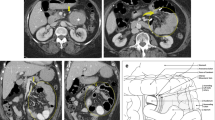Abstract
Esophageal foreign body-induced esophageal perforation is a lethal complication and its treatment very complex. We had reviewed 1,428 patients with esophageal foreign body, who were hospitalized and treated over the past 25 years. A classification summary was made of 121 patients (of these 1,428 cases) who presented with esophageal foreign body-induced perforation and complicated cervical abscess, mediastinitis, and mediastinal abscess. This summary considered foreign body types, location and lodging duration, complications, and surgical approaches. Among these 121 patients, esophageal foreign bodies in 81 patients were successfully extracted via esophagoscope or fiber optic esophagoscope. Cervical esophageal foreign bodies in 22 patients were extracted by esophagoscope and lateral cervical incision (n = 6) and simple lateral cervical incision (n = 16). Thoracotomy was performed to remove thoracic esophageal foreign bodies in 18 patients with 10 successes and 8 failures. Of the 121 patients, 67 patients with cervical abscess were cured by means of lateral cervical abscess incision and drainage, esophageal stent placement, and esophageal perforation repair with pedicle myolemma or pedicle muscular periosteum flap. 54 patients with mediastinitis and/or abscess were all cured, except one mortality, by means of mediastinotomy and drainage or/and closed-chest drainage, simple esophageal repair, esophageal repair with pedicle myolemma or pedicle muscular periosteum flap and stent placement for esophageal perforation, and esophageal exclusion plus two-stage gastric-pharyngeal anastomosis. In the treatment of esophageal foreign body-induced severe complications, various therapies should be applied simultaneously. Lateral cervical incision should be made immediately to remove the foreign bodies if the foreign body extraction under esophagoscope proves to be a failure after repeated attempts, or esophageal perforation develops during the procedure, or should cervical abscess develop. Mediastinotomy and drainage or/and closed-chest drainage should be carried out as early as possible when mediastinitis and/or mediastinal abscess develops after esophageal foreign body ingestion.



Similar content being viewed by others
References
Gonzalez JH, Vidal JM, Sarandese AG, Barro VC (1991) Esophagus foreign bodies in adult. Otolaryngol Head Neck Surg 105(4):649–654
Athanassiadi K, Gerazounis M, Metaxas E, Nikolitsa K (2002) Mangement of esophageal foreign bodies: a retrospective review of 400 cases. Eur J Cadio-thoracic Surg 21(4):653–656
Mosca S, Manes G, Martino R, Amitrano L (2001) Endoscopic management of foreign bodies in the upper gastrointestinal tract. Endoscopy 33(8):692–696
Stiles BM, Wilson WH, Bridges BM, Choudhury A, Rivera-Arias J, Nguyen DB, Edlich RF (2000) Denture esophageal impaction refractory to endoscopic removal in a psychiatric patient. J Emerg Med 18(3):323–326
Eigenberg M, Arrangoiz R, Nigliazzo A, Morrison C, Mosher B, Kepros J (2010) Nonoperative management of an esophageal perforation following combitube placement. J Surg Radiol 1(1):1–4
Lang MH, Bruns DH, Schmitz B, Wuerl P (2006) Esophageal perforation: principles of diagnosis and surgical management. Surg Today 36:332–340
Loh SK, Tan LKS, Smith DJ, Yeoh KH, Dong F (2000) Complications of foreign bodies in the esophagus. Otolaryngol Head Neck Surg 123:613–616
Alsoub H, Chacko KC (1995) Descending necrotising mediastinitis. Postgrad Med J 71:98–101
Wheatley MJ, Stirling MC, Kirsh MM, Gago O, Orringer MB (1990) Descending necrotizing mediastinitis: transcervical drainage is not enough. Ann Thorac Surg 49:780–784
Hsu F, Wu PY, Ho CK (2011) Transcervical drainage for descending necrotizing mediastinitis may be sufficient. Otolaryngol Head Neck Surg 26: Epub ahead of print
Lang MH, Bruns DH, Schmitz B, Wuerl P (2006) Esophageal perforation: principles of diagnosis and surgical management. Surg Today 36:332–340
Michel L, Grillo HC, Malt RA (1981) Operative and nonoperative management of esophageal perforation. Ann Surg 194(1):57–63
Leers JM, Vivaldi C, Schäfer H, Bludau M, Brabender J, Lurje G (2009) Endoscopic therapy for esophageal perforation or anastomotic leak with a self-expandable metallic stent. Surg Endosc 23(10):2258–2262
Johnsson E, Lundell L, Liedman B (2005) Sealing of esophageal perforation or ruptures with expandable metallic stents: A prospective controlled study on treatment efficacy and limitations. Dis Esophagus 18:262–266
Tovi F, Gittot A (1983) Sternocleidomastoid myoperiosteal flap for the repair of laryngeal and tracheal wall defects. Head Neck Surg 5(5):447–451
Lai ATY, Chow TL, Lee DTY, Kwok SPY (2003) Risk factors predicting the development of complications after foreign body ingestion. Br J Surg 90:1531–1535
Nandi P, Ong GB (1978) Foreign bodies in the oesophagus: review of 2394 cases. Br J Surg 65:5–9
Conflict of interest
None.
Author information
Authors and Affiliations
Corresponding author
Rights and permissions
About this article
Cite this article
Peng, A., Li, Y., Xiao, Z. et al. Study of clinical treatment of esophageal foreign body-induced esophageal perforation with lethal complications. Eur Arch Otorhinolaryngol 269, 2027–2036 (2012). https://doi.org/10.1007/s00405-012-1988-5
Received:
Accepted:
Published:
Issue Date:
DOI: https://doi.org/10.1007/s00405-012-1988-5




